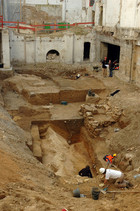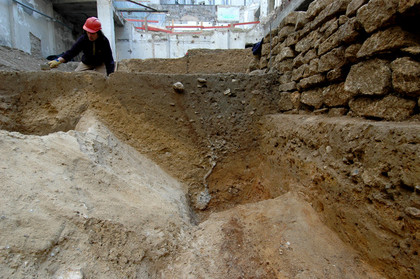Medieval History

An excavation on the rue de Rivoli is currently uncovering the first Medieval city fortifications of Paris. This excavation by an Institut national des recherches archaeologiques preventives team has found a deep ditch on land isolated among a group of buildings. This earth and wood fortification comprised a ditch and a bank, which probably held in place a wooden palisade. The bank and the palissade were destroyed when the fortification was abandoned, and have left no traces. The ditch, however, was preserved under existing Paris buildings and has now been rediscovered.
Visible for about 20 metres, this V-shaped dry ditch is approximately 12 metres wide and 3 metres deep. Being the only fortification in the capital with no preserved built remains, it is the most poorly documented. Consequently it has sometimes been called the "Carolingian wall" and at other times the "11th century wall". It is the second city wall of Paris, situated between that built in Late Antiquity (early 4th century, on the Ile de la Cité) and that of Philip Augustus (around 1200, built on both banks). From the 10th century onwards, after the Viking invasions and particularly during the siege of Paris from 885-886, the right bank experienced significant economic and urban development and its protection thus became a necessity.

After its destruction, this fortification was simply forgotten. During the 18th century, historians suspected its existence and attempted to identify its plan through toponymical indications: porte Baudoyer, archet Saint Merri, etc. Different plans were proposed based on the study of land boundaries. Today researchers agree that the wall surrounded the church of Saint-Gervais to the east, the churches of Saint-Merri and Sainte-Opportune (which no longer exists) to the north, after which it followed the rue de la Ferronnerie and ended at the church of Saint-Germain-l'Auxerrois. This last section was the most disputed, with some authors proposing shorter fortifications ending at Châtelet and leaving Saint-Germain-l'Auxerrois unprotected. The discovery of the ditch at the rue de Rivoli confirms the position of the eastern section.
The age of this defensive construction and its political context remain to be clarified. The hypothesis that it was attacked by the great Viking army during the siege of 885-886 is no longer tenable. The first elements dating it to the 10th-11th centuries were found in 1995 during an excavation by Afan at 15 rue du Temple. The pottery found at the rue de Rivoli will help to better date the fortifications.
Should they, for example, be attributed to Eudes, Count of Paris during the siege, who was later King from 888 to 893, or his brother Robert, even more briefly King from 922-923, or perhaps to Hugues Capet at the end of the 10th century? The 10th century was indeed a period of transition during which the power of the Carolingians weakened while that of the Robertians (Counts of Paris and ancestors of the Capetians) increased.
- Successful Hunt For Lost Dartmoor Manor
A recent archaeological excavation to discover the remains of the lost manor of North Hall in Widecombe-in-the-Moor has been heralded a success. The community excavation was led by Andy Crabb, Archaeologist for Dartmoor National Park Authority. Andy Crabb...
- Moothill At Scone?s Palace About A Thousand Years Old, Archaeologists Find
Archaeologists have discovered that the Moothill built at Scone Palace in central Scotland was built between the late ninth century and early 11th century. The Moothill has been famous for being the site where Robert Bruce was crowned King of Scots in...
- Archaeologists Find Remains Of Nevern Castle In Wales
Archaeological excavations on the site of Nevern Castle in Wales has revealed a large group of buildings thought to date from the 12th century. It is hoped that the discovery will provide new details on the history of the Norman fortress that was built...
- Dublin's Viking Wall Can Now Be Seen
Dublin?s 900-year-old Viking city wall has been put on public view for the first time at the city council's civic offices on the Southside. The wall was discovered during excavations of the site in the late 1970s and early 1980s in preparation for...
- On My Desk: The Twelve Children Of Paris By Tim Willocks
I purchased The Twelve Children of Paris even before I was halfway through the first book in this series (trilogy?), The Religion. I was so moved by the skill and beautiful writing in The Religion, that I had to buy the follow up book as soon as possible....
Medieval History
Paris rediscovers its first medieval fortifications
An excavation on the rue de Rivoli is currently uncovering the first Medieval city fortifications of Paris. This excavation by an Institut national des recherches archaeologiques preventives team has found a deep ditch on land isolated among a group of buildings. This earth and wood fortification comprised a ditch and a bank, which probably held in place a wooden palisade. The bank and the palissade were destroyed when the fortification was abandoned, and have left no traces. The ditch, however, was preserved under existing Paris buildings and has now been rediscovered.
Visible for about 20 metres, this V-shaped dry ditch is approximately 12 metres wide and 3 metres deep. Being the only fortification in the capital with no preserved built remains, it is the most poorly documented. Consequently it has sometimes been called the "Carolingian wall" and at other times the "11th century wall". It is the second city wall of Paris, situated between that built in Late Antiquity (early 4th century, on the Ile de la Cité) and that of Philip Augustus (around 1200, built on both banks). From the 10th century onwards, after the Viking invasions and particularly during the siege of Paris from 885-886, the right bank experienced significant economic and urban development and its protection thus became a necessity.
After its destruction, this fortification was simply forgotten. During the 18th century, historians suspected its existence and attempted to identify its plan through toponymical indications: porte Baudoyer, archet Saint Merri, etc. Different plans were proposed based on the study of land boundaries. Today researchers agree that the wall surrounded the church of Saint-Gervais to the east, the churches of Saint-Merri and Sainte-Opportune (which no longer exists) to the north, after which it followed the rue de la Ferronnerie and ended at the church of Saint-Germain-l'Auxerrois. This last section was the most disputed, with some authors proposing shorter fortifications ending at Châtelet and leaving Saint-Germain-l'Auxerrois unprotected. The discovery of the ditch at the rue de Rivoli confirms the position of the eastern section.
The age of this defensive construction and its political context remain to be clarified. The hypothesis that it was attacked by the great Viking army during the siege of 885-886 is no longer tenable. The first elements dating it to the 10th-11th centuries were found in 1995 during an excavation by Afan at 15 rue du Temple. The pottery found at the rue de Rivoli will help to better date the fortifications.
Should they, for example, be attributed to Eudes, Count of Paris during the siege, who was later King from 888 to 893, or his brother Robert, even more briefly King from 922-923, or perhaps to Hugues Capet at the end of the 10th century? The 10th century was indeed a period of transition during which the power of the Carolingians weakened while that of the Robertians (Counts of Paris and ancestors of the Capetians) increased.
- Successful Hunt For Lost Dartmoor Manor
A recent archaeological excavation to discover the remains of the lost manor of North Hall in Widecombe-in-the-Moor has been heralded a success. The community excavation was led by Andy Crabb, Archaeologist for Dartmoor National Park Authority. Andy Crabb...
- Moothill At Scone?s Palace About A Thousand Years Old, Archaeologists Find
Archaeologists have discovered that the Moothill built at Scone Palace in central Scotland was built between the late ninth century and early 11th century. The Moothill has been famous for being the site where Robert Bruce was crowned King of Scots in...
- Archaeologists Find Remains Of Nevern Castle In Wales
Archaeological excavations on the site of Nevern Castle in Wales has revealed a large group of buildings thought to date from the 12th century. It is hoped that the discovery will provide new details on the history of the Norman fortress that was built...
- Dublin's Viking Wall Can Now Be Seen
Dublin?s 900-year-old Viking city wall has been put on public view for the first time at the city council's civic offices on the Southside. The wall was discovered during excavations of the site in the late 1970s and early 1980s in preparation for...
- On My Desk: The Twelve Children Of Paris By Tim Willocks
I purchased The Twelve Children of Paris even before I was halfway through the first book in this series (trilogy?), The Religion. I was so moved by the skill and beautiful writing in The Religion, that I had to buy the follow up book as soon as possible....
